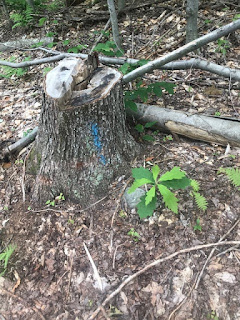ACF Update 3/23/21
Happy Spring!
As the warm weather covers our region and the sap starts to run, our winter forest management season comes to a close. After a late start, we had a good winter, although somewhat short (6-7 weeks of frozen soils, as opposed to the normal 10-12 weeks).
While we haven't completed all the work that we originally planned, we have covered a lot of ground and made a real difference in the forest at the ACF. As the forest wakes up, it will do so to a different world. Just as in the case of a natural disturbance, the forest's canopy is suddenly punctuated with gaps, the forest floor littered with debris. Over these next several years, the forest will do what it does best; responding and regenerating with resilience and abundance. Gaps will fill with diverse tree, shrub and plant regeneration, buzzing with insect life and with foraging insectivorous birds. Larger openings will fill with raspberries and blackberries, where black bears will gorge themselves in late summer, and eventually with the seedlings and saplings that precede every towering tree. The tree tops and branches left lying on the forest floor will be colonized with fungi, bacteria, invertebrates and other tiny critters, gradually sinking into the soil. The forest will look messy, but within this mess is the promise of a more diverse, more complex, more resilient living system.
If you visit the area of the Andrews Community Forest and it looks "messy" to you, please know that this is completely normal. In my experience, one of the biggest barriers to high-quality, ecological forest management is that most people have a deeply-ingrained idea of what a healthy, well-managed forest is "supposed" to look like -- an idea that has everything to do with aesthetics and very little to do with how healthy forests grow and develop. A more robust and holistic understanding of what forests are supposed to look like is something that needs to be developed -- to most people, it doesn't come naturally. Healthy forests are supposed to be "messy," with different sizes, ages and species of trees, dead standing trees, trees with holes in them and tons of dead wood on the forest floor. If you want to learn more about why Andrews looks the way it does, I'd strongly recommend checking out some of the many videos, webinars, articles and blog posts on the project, here: https://linktr.ee/ACFForestManagement
While encouraging a healthy, diverse forest, we have also produced local renewable resources that will become dimensional lumber, beautiful flooring and furniture, railroad ties, pallets and more. We have produced about 100 cords of firewood that will heat the homes of our neighbors and community members. We have produced a load of firewood that will be donated to a community firewood project and hemlock timber that will become bridges and walkways in the Andrews Community Forest, as the trail system develops. We have also generated income, which will be used to fund trail-building projects and future important stewardship projects, encouraging the health of ecosystems and public access at the ACF.
Moving forward, the ACF Committee will either decide to complete the harvest starting sometime after August 1 (no forest management is allowed in the ACF between April 1 and August 1 for bird breeding season), or decide that we've done enough. In the former case, in August or September Tim will return to work in the ACF for another month or six weeks. In the latter case, Tim will return in June or July to stabilize skid trails with an excavator.
In either case, Tim will be working up on the log landing processing firewood over the next couple months, so please continue to steer clear of his equipment, and to avoid blocking the truck road and gate. Please do not hesitate to reach out to me with any questions!
Best, Ethan Tapper
Chittenden County Forester
ethan.tapper@vermont.gov
(802) 585-9099
To join my mailing list or learn more about my work, check out: https://linktr.ee/ChittendenCountyForester



Comments
Post a Comment